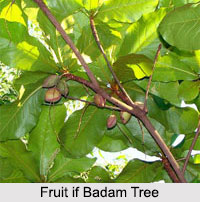 The Indian almond tree or Badam tree is a medicinal plant which is botanically known by the name of Terminalia Catappa belonging to the Combretaceae family. The Badam tree is famously known by other local names like the sea almond or the tropical almond and is commonly cultivated throughout South East Asia because of its striking features and tasty nut.
The Indian almond tree or Badam tree is a medicinal plant which is botanically known by the name of Terminalia Catappa belonging to the Combretaceae family. The Badam tree is famously known by other local names like the sea almond or the tropical almond and is commonly cultivated throughout South East Asia because of its striking features and tasty nut.
Description of Badam Tree
With a characteristic pagoda shape, the Badam tree grows to a height of 35m with an upright, symmetrical crown and a single stem from the top centre. When the single stem reaches a good height, it sends out several horizontal branches, which can get very large reaching up to 30m in ideal conditions. The fruits are almond-shaped and green turning brown to purple when ripe. The fibrous shell surrounds an edible nut which tastes very much like almonds although it can be a challenge to remove the flesh from the hard stone. This shell helps the fruit to float as the seed is dispersed by water and unlike the commercial almond, the nut from the Badam tree can be eaten raw.
The leaves of the Badam tree are large about 15 to 25cm long and 10 to 14cm broad, ovoid, glossy dark green and leathery. These oval leaves before falling turn pinkish-reddish or yellow-brown due to pigments such as violaxanthin, lutein and zeaxanthin. The Indian almond trees are monoecious with distinct white to greenish male and female flowers which are inconspicuous and not very showy. These flowers are produced on axillary or terminal spikes.
 Availability of Badam Tree in India
Availability of Badam Tree in India
The Indian almond tree or Badam tree grows throughout the warmer regions of India, including the states of Maharashtra, Karnataka, Tamil Nadu, Andhra Pradesh, and Kerala. The Indian almond tree also grows in West Bengal and other warmer regions in the North.
Uses of Badam Tree
The Indian almond tree or Badam tree is widely grown in the tropical regions as an ornamental plant, grown for the deep shade its large leaves provide. The leaves contain several flavonoids, several tannins, saponines and phytosterols. Due to this chemical richness, the leaves and the bark are used in different herbal medicines for various purposes. The leaves may contain agents for prevention of cancers and antioxidants as well as anti-clastogenic characteristics. The bark of the Badam tree is red and solid and has high water resistance.
This Indian almond tree is a medicinal plant that has great Ayurvedic properties. The fruit of the tree is considered to be a cooling agent. Each fruit is an aphrodisiac and astringent to the bowels and is used to treat biliousness and bronchitis. The seed of the Indian almond tree is edible and contains oil which is used medicinally for true almond oil. The leaves act as a sudorific and are applied to relieve rheumatic joint pain. The juice of the young leaves is used in southern India to prepare an ointment for treating scabies, leprosy and other skin diseases. This juice has great medicinal value and can be taken internally, it is said to be useful for treating colic and headache. The tannin from the leaves and bark is used as an astringent for treating dysentery. The Indian almond tree is regarded to possess properties such as diuretic and cardiotonic, and is applied externally on skin eruptions. The bark and leaves, and sometimes the roots and green fruits, are used for tanning leather, dyeing cloth and for making ink.











